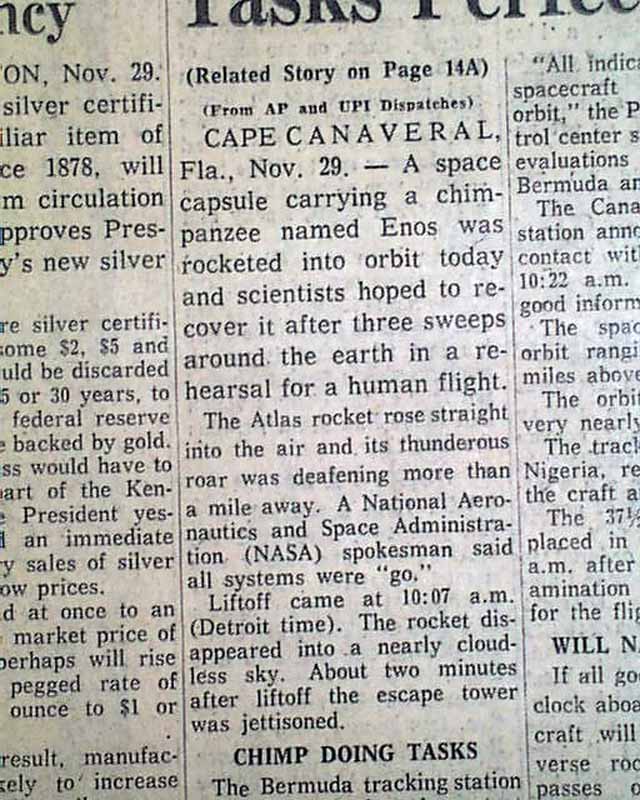
During that time, chimpanzees were used to test the forces of gravity, the effects of high-speed movement, and other conditions anticipated in space travel. The height of the space research program involving chimpanzees lasted from the early 1950s to the early 1960s. As the space race heated up, they were used increasingly as test subjects for space flight research. Mice, guinea pigs, and several species of monkeys were used in experiments prior to human space flight.Ĭhimpanzees had been used in military flight experiments starting in the early 1950s. The United States accelerated its space program and began consuming increasing numbers of nonhuman animals for space flight research.

Our deep fear of the possibility of Soviet scientific supremacy was quickly reinforced by the November launch of Sputnik II carrying the dog, Laika. Air Force secured the capture of 65 young and infant chimpanzees in Africa and used them to establish an aeronautical research facility at Holloman Air Force Base in Alamogordo, New Mexico.Īmerica’s perception of itself as the world’s preeminent scientific and technical leader was shaken in October 1957 when the Soviet Union launched Sputnik into orbit. Read more information about conditions at the Coulston Foundation. Meet some of the Air Force survivors: Dana and Hanzie. Many of these unfortunate chimpanzees ended up in the hands of Fred Coulston, a toxicologist.Ĭhimpanzees: tools for the air & space raceĬhimpanzee, name unknown, strapped for “training” Air Force (USAF) as part of the Air & Space Research program.Īfter the first successful manned space flights, the Air Force leased out most of its surviving chimpanzees for use in biomedical experiments rather than sending them to sanctuaries. Roughly forty per cent of the body was covered with second and third degree burns.ġ6 September and 26 October 1954, 8 February 1955.Ĭhimpanzees captured from their homelands in Africa were injured or killed in tests conducted by the U.S.


The chimpanzee was adequately secured against flailing, but helmet and clothing proved unsatisfactory the flying suit tore and exposed the subject to serious burning from windblast. And I said, 'Stay steady as you go and don’t stop.' Then I left the bridge and went down to the deck to help them get the capsule out of the water.Chimpanzee, name unknown, propelled for crash test I stayed on the bridge, and I set him on a course with the wind and the seas that favored recovery. “The destroyer captain was an ex-submarine guy. “I was out there on a destroyer, and there were 20-foot seas,” Thompson recalled. But finally, by December 4, the seas had calmed-a little. Rough seas had scuttled attempts to launch Sam earlier in the week. An original member of NASA’s Space Task Group, Thompson had been brought in a year earlier to head up landing and recovery operations for NASA and coordinate with the US Navy. It was up to Thompson to recover Sam, or what remained of him, after the test flight. So when NASA's young engineers at Langley Research Center in Virginia began testing their new Mercury capsule in flight, they wanted to see whether the accelerations experienced during the abort of a Mercury flight shortly after launch were survivable. In doing so, he offered a parable for NASA as it considers rescue operations for its Orion spacecraft at sea. And on a recent January morning, standing in his kitchen, Thompson did just that as he recounted the landing of Sam nearly six decades ago. Now in his early 90s, Thompson can still dominate a room with his commanding voice. Although the dry, original accounts of Sam's 1959 flight offer scant detail about the journey, mainly confirming that NASA’s new Mercury capsule kept him alive, Bob Thompson tells a more colorful story. Sam the rhesus monkey had already experienced one hell of a ride to the edge of space when he splashed down into the Atlantic Ocean-but his adventure didn’t end there. This story first ran in February 2017, and it appears unchanged below. With folks off for the holiday, we're resurfacing this odd bit of a space history from the archives-a look at the adventures of Sam the rhesus monkey, which began 60 years ago this week on December 4, 1959. Update: It's the last day of Thanksgiving weekend in the US, meaning most Ars staffers are navigating traffic as opposed to potential stories.


 0 kommentar(er)
0 kommentar(er)
